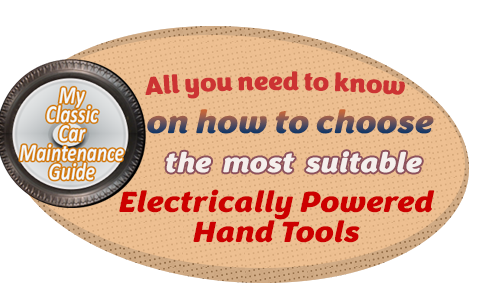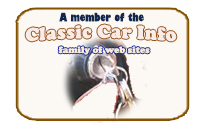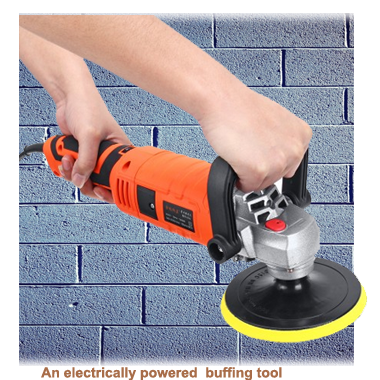
The vehicle maintenance workshops of today have becomee increasingly reliant on electrically driven power hand tools to handle the complex tasks of repairing and maintaining classic cars.
 Among the various categories of power-driven hand tools, be they battery-operated, pneumatic and even hydraulic, electrically driven power tools remain the first choice for professionals and hobbyist alike.
Providing a winning combination of steady power supply, cost effectiveness, and versatility electrically driven power tools have certain downsides, as they also come with practical limitations that need to be considered.
Among the principal advantages of electrically driven hand tools is their ability to provide uninterrupted power supply.
Among the various categories of power-driven hand tools, be they battery-operated, pneumatic and even hydraulic, electrically driven power tools remain the first choice for professionals and hobbyist alike.
Providing a winning combination of steady power supply, cost effectiveness, and versatility electrically driven power tools have certain downsides, as they also come with practical limitations that need to be considered.
Among the principal advantages of electrically driven hand tools is their ability to provide uninterrupted power supply.
 Unlike battery-operated tools that will gradually lose performance as their charge depletes, corded units will consistently deliver the same levels of constant level of torque, speed, and output throughout their working lives, carrying out tasks such as cutting, grinding and drilling. Tasks that require sustained high power without fluctuation.
Electrically driven tools sprang to prominence during the Sixties because they were so much less expensive than pneumatic alternatives which require a n expensive compressor system to power them.
When battery-driven options began to appear on the market, although the absence of cords were a definite advantage, the fact that they required their batteries to be replaced on a regular basis.
Unlike battery-operated tools that will gradually lose performance as their charge depletes, corded units will consistently deliver the same levels of constant level of torque, speed, and output throughout their working lives, carrying out tasks such as cutting, grinding and drilling. Tasks that require sustained high power without fluctuation.
Electrically driven tools sprang to prominence during the Sixties because they were so much less expensive than pneumatic alternatives which require a n expensive compressor system to power them.
When battery-driven options began to appear on the market, although the absence of cords were a definite advantage, the fact that they required their batteries to be replaced on a regular basis.
 Another plus was that unlike battery powered tools, electrically driven tools do not require charging periods, as the tool is continuously ready for use. Making for improved workflow efficiency in the busy maintenance workshop.
Maintaining corded tools involves following a much simpler maintenance programme when compared to pneumatic or hydraulic systems.
There are no air compressors to service, hoses to inspect for leaks, or batteries to monitor. For workshop owners, this translates to fewer hidden costs and reduced time spent maintaining the support.
Another plus was that unlike battery powered tools, electrically driven tools do not require charging periods, as the tool is continuously ready for use. Making for improved workflow efficiency in the busy maintenance workshop.
Maintaining corded tools involves following a much simpler maintenance programme when compared to pneumatic or hydraulic systems.
There are no air compressors to service, hoses to inspect for leaks, or batteries to monitor. For workshop owners, this translates to fewer hidden costs and reduced time spent maintaining the support.
 When compared to pneumatic tools, electrically powered ones eliminate the need for bulky compressors and piping. Although the tool itself may be heavier than its pneumatic counterpart, the overall infrastructure footprint is smaller, making corded tools more practical. especially for smaller workshops.
Certain tasks in vehicle maintenance, such as grinding valves or polishing trim, demand precise and steady tool performance are the attributes that make the consistent motor output of corded tools so attractive to maintenance workshop owners, providing es greater accuracy than battery-operated versions whose performance are known to taper off in the middle of a project.
Gradually the penny dropped for maintenance workshop owners seeking to equip a maintenance workshop on a budget, that electrically powered hand tools offered an attractive balance between affordability and functionality.
The negative sides of operating are few yet worthy of mention.
Electrically driven tools have to rely entirely on mains electricity, meaning that maintenance workshops without a stable electrical infrastructure corded tools are generally deemed as impractical.
When compared to pneumatic tools, electrically powered ones eliminate the need for bulky compressors and piping. Although the tool itself may be heavier than its pneumatic counterpart, the overall infrastructure footprint is smaller, making corded tools more practical. especially for smaller workshops.
Certain tasks in vehicle maintenance, such as grinding valves or polishing trim, demand precise and steady tool performance are the attributes that make the consistent motor output of corded tools so attractive to maintenance workshop owners, providing es greater accuracy than battery-operated versions whose performance are known to taper off in the middle of a project.
Gradually the penny dropped for maintenance workshop owners seeking to equip a maintenance workshop on a budget, that electrically powered hand tools offered an attractive balance between affordability and functionality.
The negative sides of operating are few yet worthy of mention.
Electrically driven tools have to rely entirely on mains electricity, meaning that maintenance workshops without a stable electrical infrastructure corded tools are generally deemed as impractical.
 Extended use of corded electrical tools are known to cause significant heat generation within the motor housing, especially in a workshop setting where tools are frequently used for long periods. Overheating can shorten tool lifespan while increasing the need for rest breaks, slowing down productivity.
Battery-operated tools can be taken anywhere, corded tools remain confined to the length of their cable and the proximity of a power socket.
While it is almost impossible to weigh up the advantages and disadvantages of electrically powered hand tools all day, in practice, most car maintenance workshops have set up a balance of tool types to maximise efficiency.
Extended use of corded electrical tools are known to cause significant heat generation within the motor housing, especially in a workshop setting where tools are frequently used for long periods. Overheating can shorten tool lifespan while increasing the need for rest breaks, slowing down productivity.
Battery-operated tools can be taken anywhere, corded tools remain confined to the length of their cable and the proximity of a power socket.
While it is almost impossible to weigh up the advantages and disadvantages of electrically powered hand tools all day, in practice, most car maintenance workshops have set up a balance of tool types to maximise efficiency.
 It has now been recognised that electrically driven tools perform better in tasks requiring consistent, uninterrupted power, making them the ideal choice for fixed location work such as grinding, cutting, or polishing on a bench.
Electrically driven power tools provide a winning balance of affordability, reliability, and versatility, making them almost indispensable in the modern vehicle maintenance workshop.
It has now been recognised that electrically driven tools perform better in tasks requiring consistent, uninterrupted power, making them the ideal choice for fixed location work such as grinding, cutting, or polishing on a bench.
Electrically driven power tools provide a winning balance of affordability, reliability, and versatility, making them almost indispensable in the modern vehicle maintenance workshop.
.